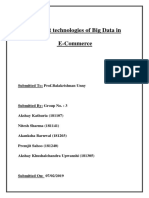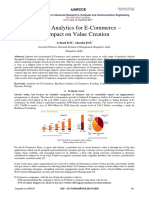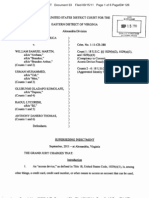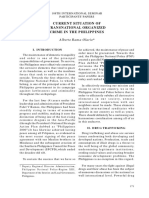FRAUD DETECTION BY USING BIG DATA IN E-COMMERCE
THULASI.R VARSHINI.M
BSc. COMPUTER SCIENCE, 2NDYEAR
Department of Computer Science (UG&PG)
Dwaraka Doss Goverdhan Doss Vaishnav College, TamilNadu, Chennai
ABSTRACT
1. Introduction to Fraud Detection Using Big Data in E-commerce
With the development of digital era, the internet has become the integral part of people’s daily lives.
People are switching from offline shopping to online shopping. The rapid growth of e-commerce has brought
numerous benefits to businesses and consumers alike. E-commerce platform generate and process massive amount of
data every second. Big data is a new type of conceptual content in recent years through the application of big data it
can effectively process huge amount of data and associates various data together. Big data in e-commerce refers to the
practice of utilizing massive volume of customer data generated through online shopping activities to gain valuable
insights , enabling business to make data-driven decisions for improved marketing strategies, personalized customer
experiences, optimized pricing, and better demand forecasting, ultimately leading to increased sales and operational
efficiency ; essentially , using large data set to understand customer behaviour and predict future trends to enhance the
overall e-commerce experience. Escalating interaction between the e-commerce platform and consumer increases the
massive amount of data circulation; data leakage has become the major problem. Personal information of customer is
not protected, and the platform uses big data advancements to collect customer information and make money.
Fraudsters frequently collect information and data from investors in order to conduct illicit transactions in
a brief span of time. The advent of contactless electronic monetary operations has resulted in the introduction of new
forms of financial fraud. It has created new opportunities for fraudsters. E-commerce fraud, which includes activities
like identity theft, payment fraud, and account takeover, can lead to significant financial losses for businesses and
erode customer trust. Traditional fraud detection methods often struggle to keep up with the scale and sophistication of
modern fraud. This is where big data comes in. By leveraging the vast amounts of data generated by e-commerce
platforms, businesses can gain deeper insights into customer behaviour and identify patterns indicative of fraud. In the
battle against e-commerce fraud, big data analytics has become a potent weapon. Large volumes of both organised and
unstructured data can be used by enterprises to uncover hidden trends, spot irregularities, and more accurately forecast
fraudulent activity. Predictive analytics, artificial intelligence (AI), and machine learning algorithms allow automated
fraud detection, which lowers losses and boosts consumer confidence. Additionally, big data enables companies to
examine consumer behaviour, transaction history, and device details, enabling them to distinguish between trustworthy
consumers and scammers.
�CHARACTERISTICS OF BIG DATA:
Big data, as used in e-commerce, is the enormous amount of structured and unstructured data produced by
online transactions, consumer interactions, and behaviour. By using this data, company insights, decision-making, and
consumer experiences may all be improved. Big data's primary attributes in e-commerce are as follows:
i) Volume: Throughout the day, e-commerce platforms produce enormous volumes of data from social media
interactions, product views, reviews, and customer transactions, among other sources. This data's enormous volume
necessitates sophisticated processing and storage systems.
ii) Variety: E-commerce big data can be classified as semi-structured (e.g., emails, product metadata), unstructured
(e.g., customer reviews, social media posts), or structured (e.g., purchase history, customer information). Drawing
significant conclusions requires handling this variability.
iii) Velocity: E-commerce data is produced in real time as a result of clients' rapid internet surfing, purchases, and
interactions. Quick processing and analysis of this data enables companies to react almost instantly to trends,
consumer behaviour, and inventory requirements.
iv) Veracity:This is a reference to the data's correctness and quality. Ensuring the accuracy and dependability of data is
essential for e-commerce in order to make well-informed business decisions. Bad decision-making and false
conclusions might result from low-quality data.
�2. APPLICATION OF BIG DATA IN E- COMMERCE:
i) CUSTOMER SEGMENTATION: Using big data can improve your current approach to client segmentation. Big
data can be more specific than just demographics of customers, such as their age, region and gender. Examining each
customer sales history and behaviour trend can help you identify previous unnoticed connections. This enables you to
create distinct customer segments and provide messages that are highly customized to each of them.
ii) SUPPLY CHAIN MANAGEMENT: Big data analytics can be used to optimize supply chain operations and reduce
costs. By analysing data from multiple sources such as suppliers, production systems, logistics networks, and market
demand, companies can gain insights into inefficiencies, bottlenecks, and opportunities for improvement .
iii) DEMAND FORECASTING: Demand forecasting is the process by which big data e-commerce companies
monitor consumer behaviour to ascertain their attitudes. Retailers have the ability to monitor consumer behaviour in
addition to their demands and personal data. When this data is combined, it can be used to predict what and when
customers will make purchases.
iv) PRICE OPTIMIZATION: The selling of a product is primarily determined by its pricing. The product's lower
process is what people typically look for. Because of this, owners of e-commerce businesses need to analyse a variety
of information sources in order to determine the right rates for their products. Maintaining competitiveness requires
this time-consuming procedure.
�TYPES OF FRAUDS IN E-COMMERCE:
i) Credit Card Fraud Card-Not-Present (CNP) Fraud:
This type of fraud happens when attackers use credit card information that has been stolen (usually from phishing or
data breaches) to make purchases online without the card being physically present. Carding: Scammers test stolen
credit card numbers by making small purchases to verify their validity before attempting larger fraudulent transactions.
ii) Account Takeover:
Account Takeover Fraud occurs when a scammer obtains unauthorized access to a victim's online account (usually by
hacking or stolen login credentials) and utilizes the account to conduct fraudulent transactions. This can involve
rerouting things by altering delivery data or making purchases using previously saved payment information.
This is particularly problematic for e-commerce websites that keep credit card information since it makes it simple for
fraudsters to make fraudulent purchases.
iii) The Fraudulent Refund:
Using stolen payment methods to buy products and then requesting a refund—usually through a return or exchange
procedure—is known as refund fraud. The goal is to use dishonest methods to obtain their money back while keeping
the items they bought. Fraudsters can also falsify or manipulate invoices or receipts to show they paid more than they
actually did for a particular item, and then ask for a larger refund than they initially paid.
iv) Online Store Frauds and Fake websites:
In order to deceive consumers into paying for things that will never be delivered, scammers establish phony e-
commerce websites that look authentic. This includes "clone sites," which have a striking resemblance to popular
shops.
v) Delivery and Shipping Fraud
Fraudsters can request a refund or chargeback by claiming that they did not receive goods or services, even when they
did.
Shipping Address Fraud: Scammers order products to be shipped to an address they control using credit card
information they have obtained with the goal of reselling them.
vi) Discount and Rebate Fraudulent Coupons:
To obtain discounts or freebies, scammers pilfer or fabricate fake discount coupons. Abusing rewards programs or
promotional offers by changing terms and restrictions to obtain undue advantages.
vii) Fake Reviews and Rating Manipulation:
False reviews and rating manipulation are dishonest tactics used by companies or people to submit biased or
inaccurate evaluations in an attempt to sway customer decisions. Negative fake reviews are meant to hurt rivals, while
positive ones are meant to enhance a product's reputation. Rating manipulation involves utilizing bots or phony
accounts to intentionally inflate or deflate product ratings. These strategies damage online reviews' credibility, deceive
consumers, and interfere with fair market competition. By using algorithms and reporting mechanisms, e-commerce
companies are attempting to identify and eliminate fraudulent reviews. Companies are urged to be genuine in order to
gain the trust of their clients over the long run.
�TYPES OF FRAUD DETECTIONS IN E-COMMERCE:
1. RULE-BASED FRAUD DETECTION:
In rule-based fraud detection, suspicious transactions are identified by applying a set of predetermined
criteria or thresholds. Usually, these regulations are founded on recognized fraud trends, including
anomalous transaction values, particular regions, or a significant volume of purchases in a brief period of
time. A transaction is marked for additional examination when it satisfies one or more of these requirements.
For instance, the system might flag a credit card transaction as possibly fraudulent if it is used to make a
purchase from a foreign nation just minutes after a local transaction.
Benefits: It is inexpensive, simple to use, and good in spotting recognized fraud trends. Cons: It can miss
novel, unidentified fraud techniques and result in false positives.
2.
��Veracity
This refers to the quality and accuracy of the data. In e-commerce, ensuring that the data is reliable
and trustworthy is crucial for making informed business decisions. Poor data quality can lead to
misleading conclusions and bad decision-making.
5. Value
The ultimate goal of big data in e-commerce is to extract valuable insights that drive business
success. By analyzing customer behavior, preferences, and purchase patterns, e-commerce businesses
can optimize marketing strategies, personalize customer experiences, and improve operational
efficiency.
6. Complexity
E-commerce data often comes from multiple sources, including websites, mobile apps, social media,
and third-party platforms. Integrating and analyzing this diverse data from various systems adds
complexity but can provide deeper insights into customer behavior and market trends.
7. Scalability
As e-commerce businesses grow, so does the volume of data. Big data solutions need to be scalable
to handle increased amounts of data without compromising speed or performance, ensuring that
businesses can continue to process and analyze data effectively as they expand.
These characteristics enable e-commerce businesses to enhance customer experiences, improve operational
efficiency, and stay competitive in a rapidly changing market.






























































































